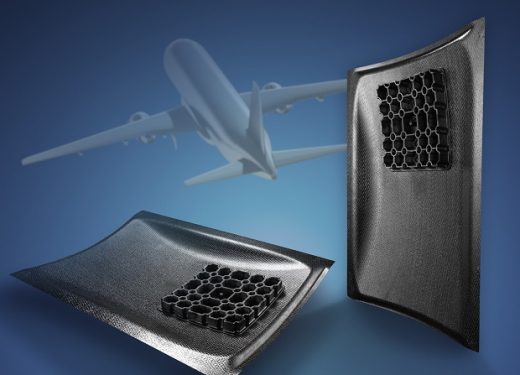 According to today’s press release from BASF, manufacturing of sandwich structures for airplane interiors are now more cost effective and quick.
According to today’s press release from BASF, manufacturing of sandwich structures for airplane interiors are now more cost effective and quick.
With the polyethersulfone Ultrason® E from BASF, manufacturers of interior airplane components can now take a great step forward in achieving this goal. The major advantage is that the same thermoplastic Ultrason® can be processed into different components of the sandwich structure in a single tool. This reduces cycle times and thus also manufacturing costs. The sandwich consists of a foam core and carbon fiber laminates, which are all made of Ultrason® E. If needed, the thermoformed foam core with cover layers can then be overmolded with the carbon-fiber reinforced Ultrason® E 2010 C6 to incorporate reinforcements, structures or additional functional elements into the sandwich. The combination of 30% carbon fibers with the amorphous high-temperature plastic Ultrason® guarantees extraordinary and constant mechanical properties for the light foam sandwich over a temperature range of -100 to +200°C.
Sandwich structures allow for particularly low weight while maintaining high flexural stiffness. Therefore this design is especially well suited for applications in the interior of airplanes, e.g. panels, side walls, luggage compartments, doors, cabin-separating walls, but also trolleys and cooking modules. Foams made of Ultrason® E have been approved for use in airplanes. The material, with its exceptionally high limiting oxygen index of 38 (according to ASTM D 2863), distinguishes itself because it meets the requirements for commercial aircraft with regard to combustibility and heat release (“fire, smoke, toxicity”) already without the addition of flame retardants, which means it is intrinsically flame retardant. This is why, for example, the Swedish aircraft supplier Diab uses the BASF polyethersulfone to manufacture foam core materials with different densities.
Sandwich components which can be manufactured thermoplastically in this way have numerous advantages compared to traditional honeycomb structures that are coated with phenolic resins: They can be produced faster in an automated process, they offer various processing options such as thermoforming into different geometries or overmolding for reinforcing ribs and additional functional integration. Thanks to weight-optimized, thermoplastic sandwich structures with additional functions it is possible to realize new lightweight materials for aviation, which have improved characteristics and a significantly reduced cost structure compared to traditional sandwich structures.
JEC Innovation Award 2018 in the category „Aerospace Process“
For the development of a demonstrator with Ultrason® as a foam core, as carrier for carbon-fiber laminates and overmolding material as well as the suitable production concept, a group from the research project “MAI Sandwich” won the JEC Innovation Award 2018 in the category “Aerospace Process.” “MAI Sandwich” is part of the leading-edge cluster “MAI Carbon” which is promoted by the German Federal Ministry for Training and Research.The project was coordinated by the Chair of Carbon Composites at the Technical University of Munich, Germany. The other partners are Airbus, BASF, BMW, SGL Carbon, Foldcore, Neenah Gessner, New Materials Bayreuth and Werkzeugbau Siegfried Hofmann. The award-winning concept shows that long cycle times can be reduced drastically to five minutes for a panel of one to three square meters using the traditional production method. This result was possible due to the optimal interplay of the few materials used and the development of an innovative, fine-tuned production sequence that combines the three techniques of thermoforming, injection molding and fusion bonding in an automated facility.
Ultrason® is the trade name for BASF’s product range of polyethersulfone (Ultrason® E), polysulfone (Ultrason® S) and polyphenylsulfone (Ultrason® P). It is used to manufacture lightweight components in the electronics, automobile and aerospace industries. The thermoplastic material can withstand high temperatures of up to 220°C without changing its characteristics, and shows extraordinary chemical resistance. The high-performance plastic is also used in water-filtration membranes and in components that come into contact with hot water and food. Because of their extraordinary property profile the Ultrason® brands can substitute thermosets, metals and ceramics.
For more information, please visit: www.ultrason.basf.com













